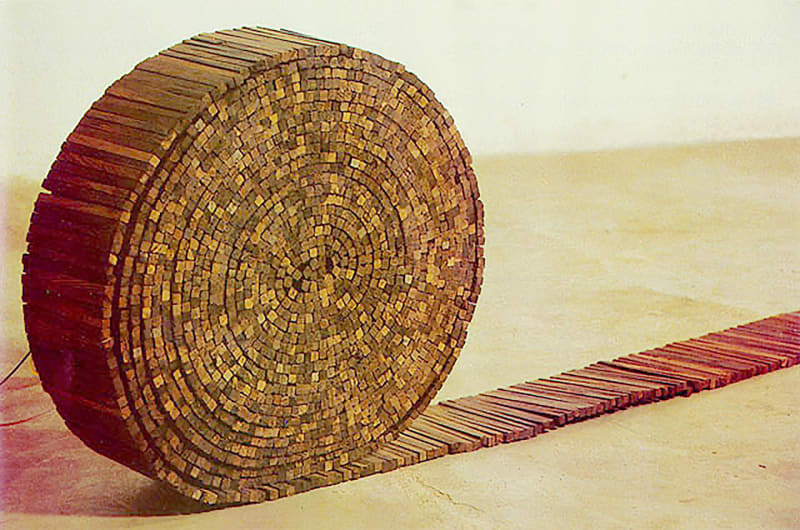José Bento Franco Chaves (Salvador, BA, 1962). Sculptor. In 1966, he moves with his family to Belo Horizonte. Self-taught, between 1981 and 1988, he creates a series of miniature scenes and environments with popsicle sticks. He exhibits part of these pieces at the Palácio das Artes, in Belo Horizonte, in 1989. That same year, he makes small wooden and glass boxes in which he draws with mercury. At this time, he begins to produce sculptures with naturally fallen trunks, often from rare and secular trees, which he collects in the Atlantic Forest region between Minas Gerais and Espírito Santo. In 1990 and 1991, he develops Roda, a work that distances himself from his previous works and boosts his participation in several group exhibitions in Brazil. He receives the Brasília Award in Plastic Arts at the 12th Salão Nacional de Artes Plásticas (1991-1992), in Rio de Janeiro. In 1993, he held a solo show at Casa Guignard in Ouro Preto, Minas Gerais. From 2000 on, he also works with glass, mirror, and granite. In 2004, he exhibited his sculptures at Museu de Arte da Pampulha (MAP), in Belo Horizonte.
In the 1980s, José Bento made small sculptures with materials such as popsicle sticks, creating everyday scenes that sometimes take on a surrealist character. As noted by critic Agnaldo Farias, these works are interesting for their diminute scale, their finishing, and their inventiveness, as in Ping-Pong (1981/1982), in which he captures the speed and trajectory of a ball in a static environment. He also creates glass and wood boxes, in which he works with mercury, and explores projections or reflections of geometric figures and shapes.
From the 1990s on, José Bento has been producing large-scale works, such as A Roda (1991), composed of juxtaposed wooden sticks connected by nylon threads, which, when spiraled, form a disc about one and a half meters high. When unrolled, the wooden strips form a ribbon that unfolds in gentle undulations in space. In Alfabeto (1994), he presents small wooden pieces with intriguing and mysterious shapes that, presented in series and arranged on a horizontal plane, reveal the source of the artist's inspiration: the view of the domes of the chapels from a cemetery near his house. As art historian Aracy Amaral points out, the presence of symbols related to death and religiosity is a constant in José Bento's poetics.
Later on, the artist began to work with old wooden trunks, obtained from naturally fallen trees in the Atlantic Forest, which bear the marks of time. The works, which at times reveal a constructive rigor, also carry within them a mysterious character. In the "hollow towers", created from 1993 on with stacked wooden slats, linearity and a lightness that is not very frequent in his production predominate.
In pieces produced since 2000, José Bento resumes previous works in wooden boxes, creating small installations with mirror and glass modules on a modular granite floor. In these works, the artist explores the ambiguity and surprise resulting from the difficulty of distinguishing between reflection and transparency as differentiated visual fields. Still in Aracy Amaral's opinion, his most recent works, which refer to modern architecture and reveal an illusionistic character, seem to indicate a new development in his production.
JOSÉ Bento. In: ENCICLOPÉDIA Itaú Cultural de Arte e Cultura Brasileiras. São Paulo: Itaú Cultural, 2021. Available at: <http://enciclopedia.itaucultural.org.br/pessoa21322/jose-bento>. Accessed on: June 26, 2021. Encyclopedia entry. ISBN: 978-85-7979-060-7

